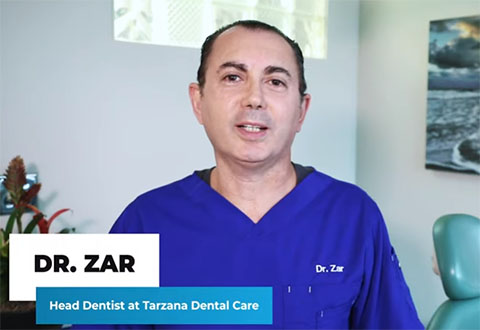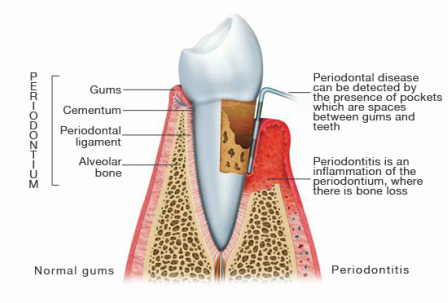

Periodontics is the branch of dentistry that focuses on the health of bones and tissues that support your teeth. When bacterial build-up is threatening the health of your smile, there are two alternatives: non-surgical and surgical periodontics.
Periodontal diseases can create serious dental problems for many patients and effect the gums and soft tissues around the teeth.
Regular cleanings and examinations remain the most effective methods in reducing the occurrence of periodontal diseases such as gingivitis.
Gingivitis Treatments
Periodontal, or “gum” cleanings are used to treat gum disease. Gum disease is caused by heavy plaque and tartar buildup. Over time, plaque causes gums to become inflamed and bleed easily, which is a condition called gingivitis. Untreated, gingivitis can turn into periodontal disease, causing gums to pull away from teeth. Painful pockets of disease can destroy bones, gums and tissue. This is a serious and very painful condition that our dentists can treat with scaling or root planing.
Types of Periodontal Treatment

Non-Surgical:
A hand scaler/curette is used to remove plaque or calculus at or below the gum line.
Tooth root surfaces may be smoothed using Periodontal Debridement.
A laser is used to treat bacterial pockets along the gum-line.
Surgical:
Gum-grafting: to restore eroding gum tissue.
Crown Lengthening: reshaping the gum and supporting tissue to be able to place a restoration properly.
Bone Grafting: replacing bone tissue for the successful placement of an implant.
Periodontal Treatment
Periodontal treatment methods depend upon the type and severity of the disease. You will be screened and evaluated for periodontal disease and our office will recommend the appropriate treatment.
Periodontal disease progresses as the sulcus (pocket or space) between the tooth and gums gets filled with bacteria, plaque, and tartar, causing irritation to the surrounding tissues. When these irritants remain in the pocket space, they can cause damage to the gums and eventually, the bone that supports the teeth!
If the disease is caught in the early stages of gingivitis, and no damage has been done, one to two regular cleanings will be recommended. You will also be given instructions on improving your daily oral hygiene habits and having regular dental cleanings.
If the disease has progressed to more advanced stages, a special periodontal cleaning called scaling and root planing (deep cleaning) will be recommended. It is usually done one quadrant of the mouth at a time while the area is numb. In this procedure, tartar, plaque, and toxins are removed from above and below the gum line (scaling) and rough spots on root surfaces are made smooth (planing). This procedure helps gum tissue to heal and pockets to shrink. Medications, special medicated mouth rinses, and an electric tooth brush may be recommended to help control infection and healing.
If the pockets do not heal after scaling and root planing, periodontal surgery may be needed to reduce pocket depths, making teeth easier to clean. It may be recommended that you see a Periodontist (specialist of the gums and supporting bone).
Periodontists specialize in the treatment of gum disease and the placement of dental implants. A periodontist can perform effective cleaning procedures in deep pockets such as scaling and root planing, and also prescribe antibiotic and antifungal medications to treat infection and halt the progression of the disease.
In the case of tooth loss, the periodontist is able to perform tissue grafts to promote natural tissue regeneration, and insert dental implants if a tooth or several teeth are missing. Where gum recession causes a “toothy” looking smile, the periodontist can re-contour the gingival tissue to create an even and aesthetically pleasing appearance.
Preventing periodontal disease is critical in preserving the natural dentition. Addressing the causes of gum disease and discussing them with your dentist will help prevent the onset, progression, and recurrence of periodontal disease.
POST OP INSTRUCTIONS: Scaling and Root Planing
Following scaling and root planing, you can expect to notice less redness, bleeding and swelling of your gum tissue. Your mouth will taste and feel better. Your gum health can then be maintained with proper homecare and regular professional care.
DISCOMFORT
Discomfort immediately after treatment usually involves a slight throbbing or aching. Discomfort or pain should subside in a few hours following the procedure.
TOOTH SENSITIVITY
Teeth may be sensitive to temperature changes and | or sweets. The sensitivity to temperature may be noticeable for the first several day and usually diminishes quickly. Application of desensitizing fluoride may be recommended.
BLEEDING
Some slight bleeding may occur during the next several brushings but the bleeding should steadily decrease.
APPEARANCE
As the gums heal they may change their shape around the teeth. This is normal as they tighten.
INSTRUCTIONS TO MINIMIZE SYMPTOMS:
DIET | EATING
If extensive root planing was performed, chewing hard foods, such as meat or raw vegetables may be uncomfortable; this should last no longer than a few days. A diet of a softer consistency is advised until chewing becomes more comfortable.
DISCOMFORT | SENSITIVITY
If a local anesthetic was used avoid chewing foods until feeling returns to avoid injury to the tongue or cheeks. Acetaminophen or a non-aspirin analgesic should be taken as recommended to reduce discomfort. If tooth sensitivity persists, use a desensitizing toothpaste containing potassium nitrate such as Sensodyne. If the sensitivity is severe and prolonged, professional application of a desensitizing agent may be required.
ORAL HYGIENE
If gum tissues are tender, brush your teeth gently but thoroughly; this may take a little more time than normal. By the third or fourth day, normal oral hygiene techniques may be resumed. Mouth rinsing is recommended with either of the following solutions: 1) an anti-microbial rinse 2) a warm salt-water rinse. Use of either of these rinses should be limited to one to two consecutive weeks.
SPECIAL INSTRUCTIONS
If symptoms are severe or persistent, please call our office immediately.
